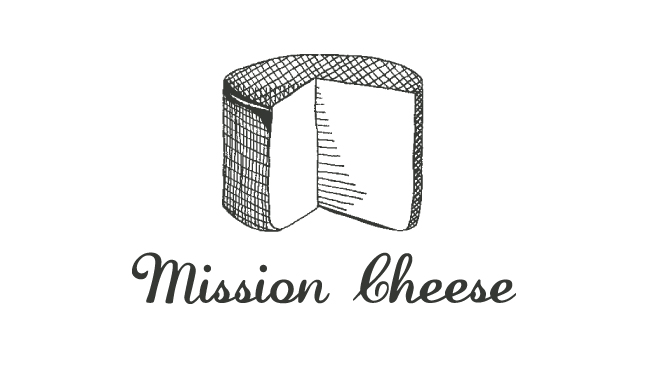 On Monday, June 25th, the staff at Mission Cheese traveled to Barinaga Ranch in Marshall, California. The first excursion of many to come, the day promised a lesson in Basque-style sheep milk cheese making as well as a tour of the ranch itself. It did not disappoint. Marcia Barinaga the proprietor of Barinaga and the keeper of its 65 sheep greeted us at the entrance to her shipping container turned creamery with hair nets and booties in hand. We were there to help turn out and brine her beloved Baserri and Txiki (pronounced "cheeky").
On Monday, June 25th, the staff at Mission Cheese traveled to Barinaga Ranch in Marshall, California. The first excursion of many to come, the day promised a lesson in Basque-style sheep milk cheese making as well as a tour of the ranch itself. It did not disappoint. Marcia Barinaga the proprietor of Barinaga and the keeper of its 65 sheep greeted us at the entrance to her shipping container turned creamery with hair nets and booties in hand. We were there to help turn out and brine her beloved Baserri and Txiki (pronounced "cheeky"). Marcia, a microbiologist and science writer by trade, slid into the world of cheese making with the desire to continue her family's tradition of producing Basque-style cheeses, a practice
that was passed on through her father, a sheep herder from Idaho. Although her bent was scientific, Marcia's tone was loving as she discussed the procedure from milking to forming to brining to aging. The ranch in its second season has doubled in production fr om 3000 to 6000 pounds of cheese produced annually and this growth in size can be attributed to the careful sorting of the ranch's best producing ewes (we came to learn that a sheep called Panties and another called Guapa were leading the pack in production).
om 3000 to 6000 pounds of cheese produced annually and this growth in size can be attributed to the careful sorting of the ranch's best producing ewes (we came to learn that a sheep called Panties and another called Guapa were leading the pack in production).
Our task, and we chose to accept it, was to weigh each freshly made Baserri (large format) and Txiki (small format) cheese, record their weights, and place them on the cart for brining and aging. The brining liquid was a saturated solution that included three different bacterium - B-Linens, Microdor, and Geotrichum. These bacteria contribute to the taste as well as the appearance of the cheese: B-Linens, for instance, usually the primary bacterium for most washed rinds, promotes the orange color that's become notorious as well as a fragrant meaty pungency that lingers in the air as well as the tongue. This bacterium gives the Baserri a yellowish tint and an earthy flavor.
While the cheese swam in solution, our team moved on to the milking room, a large tin barn where assistants Lolo and Ignacio shepherded the ewes on to the line for eating and milking. Utters were cleaned with iodine and then placed into the mechanized milker. Five at a time, the sheep moved up the ramp for their daily deposit, turning the din from whine to purr. Marcia told us that everyday it's the same order, the last four ewes
 consistently the stragglers. A high point of the visit was trying the fresh sheep's milk, creamy and sweet, only hours from the utter.
consistently the stragglers. A high point of the visit was trying the fresh sheep's milk, creamy and sweet, only hours from the utter.
A visit to Barinaga could not have been complete without a visit to the nursery, lamb nursery that is. Three of them, one black two white, were waiting rather impatiently for their afternoon feeding. Bottles were filled with fresh milk and each of us had a turn feeding the babes. We learned after that these three girls would soon be on their way to slaughter, as genetically they were unfit milkers. Oh, the ways of the farm!
After we bid farewell to Marcia, our day in Marshall continued at Nick's Cove, a roadside oyster bar and
 restaurant. Due to excellent timing, we were able to take over the adjacent boat house building that sits away from the restaurant down a long wooden dock. We enjoyed 3 dozen oysters , several seafood chowders, a pasta bolognese, and some roasted scallops with corn.
restaurant. Due to excellent timing, we were able to take over the adjacent boat house building that sits away from the restaurant down a long wooden dock. We enjoyed 3 dozen oysters , several seafood chowders, a pasta bolognese, and some roasted scallops with corn. As the sun set on Tomales Bay, we began our journey back over the Golden Gate Bridge. Our first excursion as a staff was complete, but the feelings generated and the warmth shared would indeed linger on. I can only speak for myself, but the visit to Barinaga has made me more proud of the product we sell, as it is a byproduct of the passion and dedication felt by cheese makers like Marcia Barinaga.
Be sure to come to Night Cheese on August 11th to meet our staff and discuss the many other cheeses we are proud to showcase at Mission Cheese!
